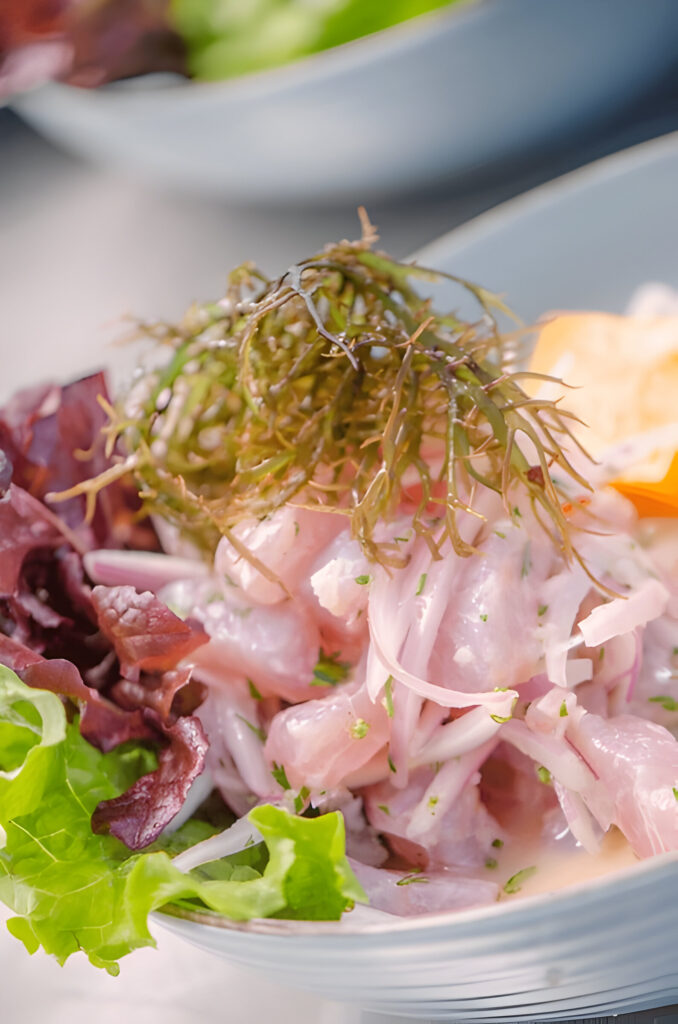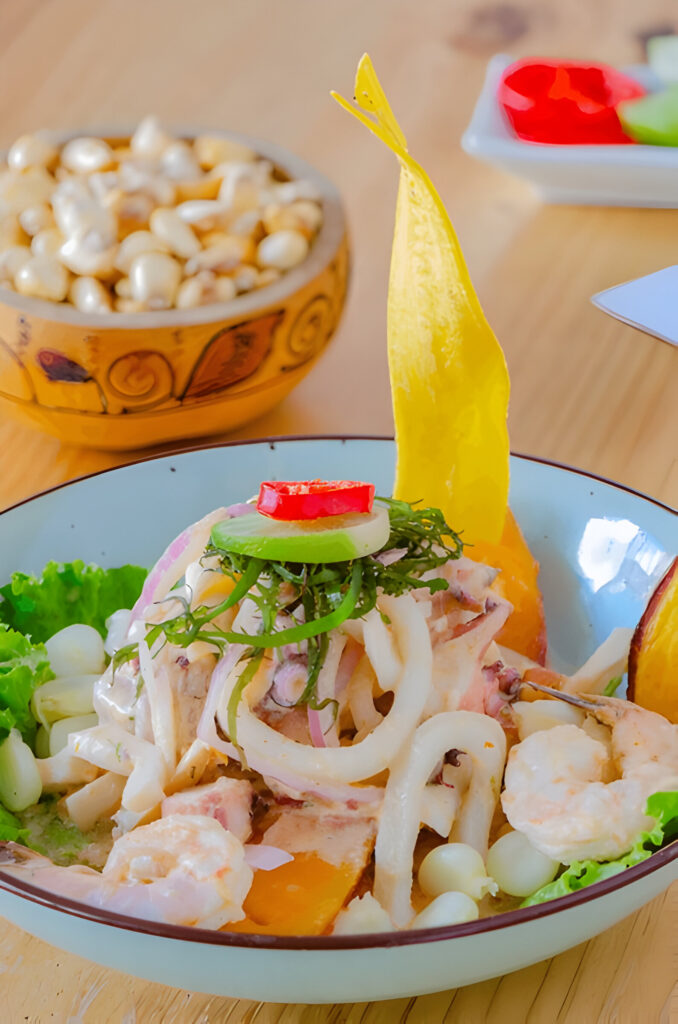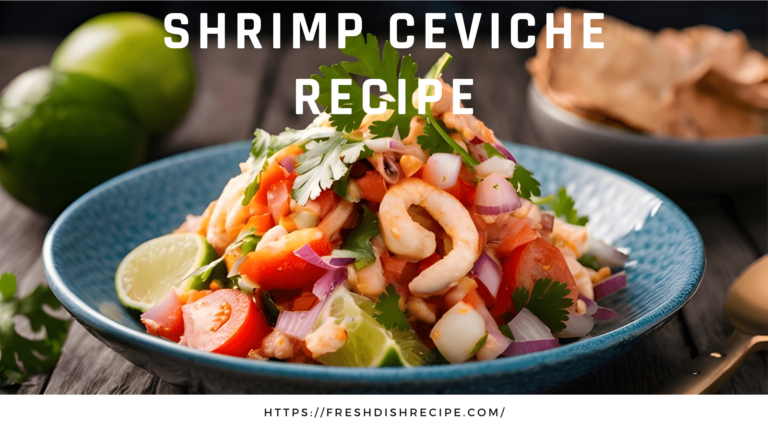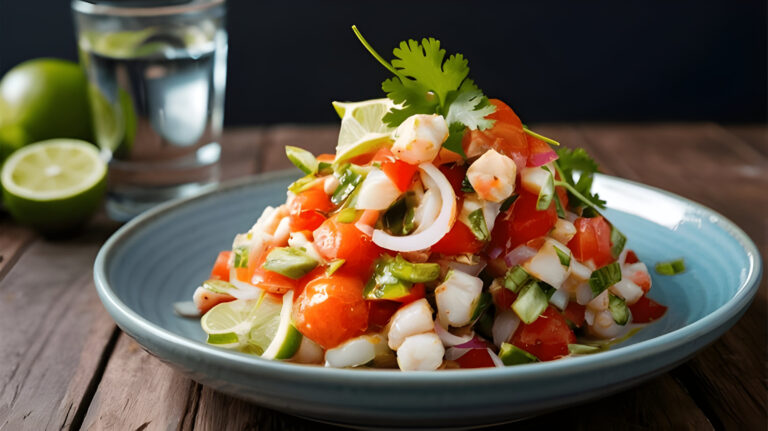Table of Contents
Peru, a nation blessed with a vibrant culinary heritage, boasts an array of dishes that reflect its diverse culture and history. Among these, ceviche stands out as the national dish, embodying the essence of Peruvian cuisine. This delicacy, known for its fresh, zesty flavors and meticulous preparation, is more than just a meal—it is a celebration of Peru’s rich coastal resources and its fusion of indigenous and global influences.
The Origins of Ceviche: A Historical Perspective
Ceviche’s roots can be traced back thousands of years, long before the arrival of the Spanish in South America. The earliest evidence of a dish resembling ceviche comes from the Moche civilization in northern Peru, dating as far back as 2,000 years. The Moche people, who thrived along the coast, were known for their fishing prowess, and it is believed they began preparing fish with fruit juices, possibly fermented chicha, to preserve their catch.
With the arrival of the Spanish in the 16th century, new ingredients such as citrus fruits—most notably limes—were introduced. The combination of native methods with these new ingredients gave birth to the ceviche we know today, a dish that marries ancient tradition with colonial influence. This culinary blend not only highlights Peru’s rich history but also underscores the nation’s ability to adapt and innovate.

The Essential Ingredients of Peruvian Ceviche
At its core, Peruvian ceviche is a simple dish, yet each ingredient plays a crucial role in creating the final product. The traditional recipe includes:
- Fresh Fish: The quality and freshness of the fish are paramount. Commonly used fish include corvina (sea bass), mahi mahi, and grouper. The fish is typically cut into bite-sized pieces to ensure even marination.
- Lime Juice: The juice of freshly squeezed Peruvian limes is the key to ceviche’s bright, tangy flavor. The acidity of the lime juice “cooks” the fish, giving it a firm texture and opaque color.
- Onion: Red onions, thinly sliced, add a sharp bite and crunch to the dish, balancing the softness of the fish.
- Aji Pepper: Aji limo or aji amarillo peppers are often used to provide a spicy kick. These peppers are essential in giving Peruvian ceviche its distinctive heat and vibrant color.
- Cilantro: Fresh cilantro leaves add a burst of herbal freshness, enhancing the overall flavor profile.
- Salt: A touch of salt brings all the flavors together, highlighting the natural sweetness of the fish and the brightness of the lime.
The Art of Preparation: How Ceviche is Made in Peru
The preparation of ceviche in Peru is as much about technique as it is about ingredients. The process begins with selecting the freshest fish, ideally caught on the same day. The fish is then meticulously cleaned and cut into uniform pieces.
The fish is then combined with freshly squeezed lime juice, allowing the acidity to penetrate the flesh. This “cooking” process takes just a few minutes, ensuring the fish remains tender and flavorful. Sliced onions, chopped cilantro, and thinly sliced aji peppers are then added to the mix, creating a dish that is both visually appealing and delicious.
One of the unique aspects of Peruvian ceviche is its short marination time. Unlike other variations found in Latin America, Peruvian ceviche is served almost immediately after the fish has been mixed with the lime juice, preserving the freshness and delicate texture of the fish.

Regional Variations: The Diversity of Ceviche Across Peru
While the basic components of ceviche remain consistent throughout Peru, there are notable regional variations that reflect the country’s diverse geography and culture.
Ceviche Norteño (Northern Ceviche)
In the northern coastal regions, such as Piura and Tumbes, ceviche is often prepared with the addition of chicha de jora, a fermented corn beverage. This gives the dish a unique depth of flavor. Northern ceviche also tends to be spicier, with a generous amount of aji peppers.
Ceviche Limeño (Lima-style Ceviche)
In Lima, the capital of Peru, ceviche is typically served with a side of cancha (toasted corn kernels) and sweet potato. The combination of the tangy, acidic ceviche with the sweetness of the potato and the crunch of the corn creates a harmonious balance of textures and flavors.
Ceviche de Conchas Negras (Black Clam Ceviche)
This variation, popular in the northern coastal regions near the border with Ecuador, is made with black clams (conchas negras) instead of fish. The clams give the dish a dark color and a richer, more intense flavor.

Ceviche Amazónico (Amazonian Ceviche)
In the Amazon, ceviche takes on a different form, often using freshwater fish such as paiche or tambaqui. The dish might include local fruits like cocona or aguaje to add a touch of sweetness and acidity, highlighting the unique flavors of the Amazon region.
Ceviche: A Symbol of Peruvian Identity
Ceviche is more than just a dish; it is a symbol of Peruvian identity. It represents the country’s rich culinary tradition and its ability to embrace and adapt to foreign influences. The dish is celebrated annually on June 28th, known as National Ceviche Day, a testament to its significance in Peruvian culture.
Ceviche is also a reflection of Peru’s natural bounty. The country’s extensive coastline, with its cold waters rich in marine life, provides the perfect environment for the fish and seafood that form the backbone of ceviche. This connection to the land and sea is a source of pride for Peruvians, and it is one of the reasons why ceviche holds such a special place in their hearts.
Pairing Ceviche with Traditional Accompaniments
The experience of enjoying ceviche is often enhanced by its traditional accompaniments. Peruvian corn (choclo), with its large, chewy kernels, is a popular side that adds texture and a subtle sweetness. Sweet potato (camote), often served boiled or roasted, provides a comforting contrast to the acidity of the ceviche.
In some regions, ceviche is also accompanied by yuca (cassava) or plantain chips, adding an extra layer of crunch and flavor. These sides not only complement the ceviche but also showcase the diverse agricultural products of Peru.
The Global Influence of Peruvian Ceviche
In recent years, Peruvian ceviche has gained international acclaim, becoming a staple in many top restaurants around the world. Chefs have embraced ceviche for its fresh, vibrant flavors and its versatility, adapting it to suit local ingredients and tastes.
This global influence has also led to the creation of new ceviche variations, incorporating elements from other cuisines. However, traditional Peruvian ceviche remains the gold standard, admired for its authenticity and simplicity.

Ceviche as a Culinary Experience: Where to Find the Best in Peru
For those seeking the ultimate ceviche experience, Peru offers a myriad of options. The city of Lima, often referred to as the gastronomic capital of South America, is home to numerous cevicherías where one can savor this iconic dish. La Mar Cebichería, El Mercado, and Punto Azul are just a few of the renowned establishments where ceviche is prepared with the utmost care and attention to detail.
Beyond Lima, the coastal towns of Piura, Trujillo, and Arequipa also offer exceptional ceviche, each with its regional twist. Visiting these places provides a deeper understanding of the dish and its significance in Peruvian culture.
Conclusion: Celebrating Peru’s Culinary Treasure
Ceviche is not just the national dish of Peru; it is a culinary treasure that encapsulates the essence of the country’s rich history, diverse culture, and natural abundance. Its simplicity, freshness, and bold flavors have made it a beloved dish not only in Peru but around the world. As we celebrate ceviche, we also celebrate the ingenuity and spirit of the Peruvian people, who have turned this humble dish into a symbol of national pride.
Whether you are enjoying ceviche in a bustling Lima restaurant or in a quiet coastal village, you are partaking in a tradition that spans centuries and connects you to the heart of Peru.







